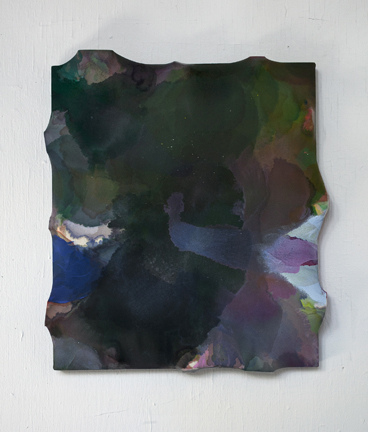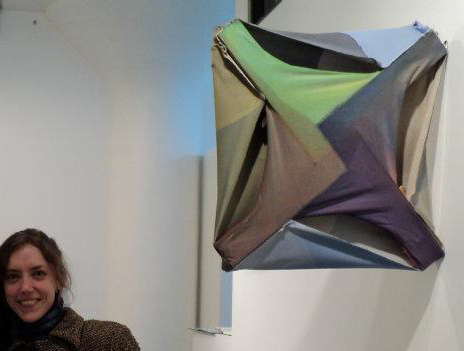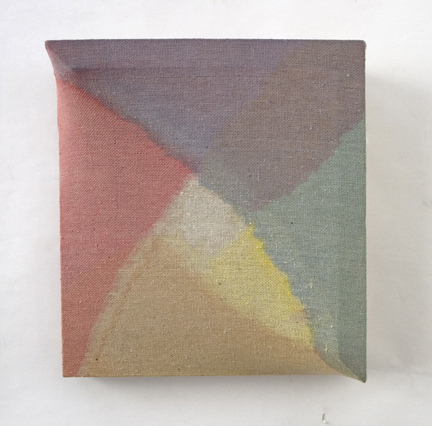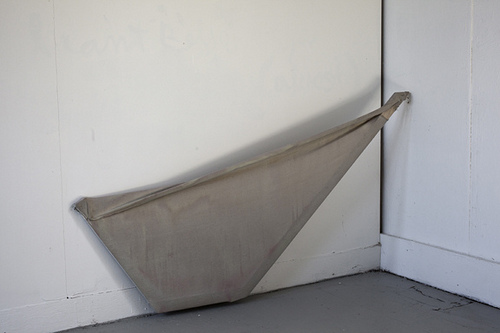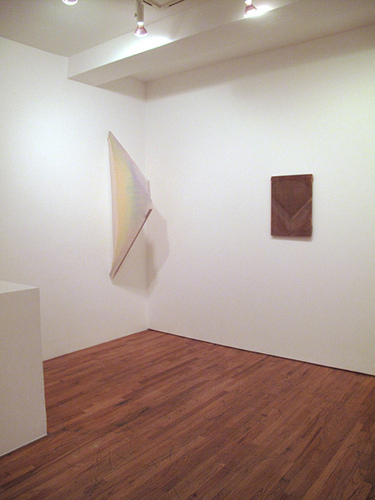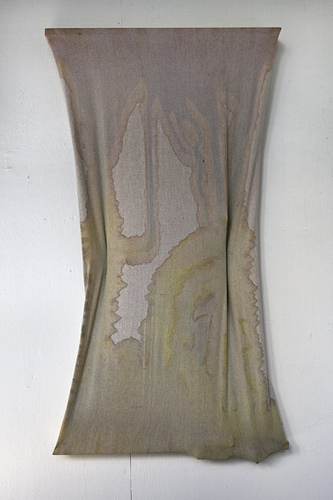Maria Walker lives and works in Brooklyn, NY. She received her MFA from Tyler School of Art and her BA from Brown University. Her work has recently been exhibited in New York, Los Angeles, San Diego, Richmond, Providence and Baltimore.
Tell us a little bit about yourself and what you do. I live in Crown Heights, Brooklyn with my husband, Jonathan Allmaier, who is also a painter. We have our studios at home. I make paintings and work and cook and run.
What materials do you use in your work and what is your process like? I use acrylic paint (usually Golden fluid), canvas, wood, staples, wood screws, wood glue, D-rings. The limit of the materials is important, but within these limits there is a range to be mined. Poplar wood vs. pine. Different weights of canvas vs. drop cloth vs. fabric. These differences directly affect scale, weight, color, just as much as the paint. I start with the stretcher, making what could be described as a three-dimensional drawing. Next I stretch the canvas, and inevitably a new form exists. The paint comes in response to this form with the aim to find a balance of these materials that lets the painting take life in the world. Sometimes the steps stop there. Sometimes they circle back to the stretcher or the canvas or follow parameters created by the object.
What kinds of things are influencing your work right now? Furniture—Shaker furniture—and the instrument wing at the Met. For both I’ve been thinking about simplicity, utility, and scale to the body.
How has your work developed within the past year? My process is slowly changing. Some of the paintings are coming off the wall, standing on their own. The stretchers are taking on a new life separate from canvas and paint, and I have started to think about the paint in different ways, using the brush again and reconsidering thoughts on color. I think rules naturally develop in an artist’s studio which help move the work forward. Then eventually those rules need to be reconsidered and changed so that the work can continue to open up and grow.
What are some recent, upcoming or current projects you are working on? I’m excited for a show I’m having in August in the carriage house at John Davis Gallery in Hudson. I’ll have three small rooms and an ancient bathroom on the second floor for my work. It’s an unusual space—a minimally restored carriage house, which is used to exhibit one or two artists on each floor in the summer months. The rooms have unusual scale and shape, beautiful light. I’m excited to take a bunch of work up for the show and work on an installation that finds a balance between the paintings and the space.
What do you want a viewer to walk away with after seeing your work? I don’t think it’s my place to say. That’s between the painting and that person. I try to make what seems to me to be the most specific, integral work I can. And then let it out into the world.
How did your interest in art begin? My father was a printmaker/art professor at Oberlin College. I grew up making prints in the studios at Oberlin. My dad’s father was an architect and his father was a political cartoonist and painter. My mom is a folklorist and made a point of having my sister and I grow up seeing and hearing all kinds of art. As a child I loved the thought that I could carry on this lineage of artists in our family. In college I made the leap to really think of myself as an artist.
What artists are you interested in right now? I visited the DuChamp rooms while I was at the Philadelphia Museum of Art recently. I have seen those rooms many times before, but this time something clicked. Something about DuChamp’s relationship to chess and the small quantity of work he made. I want to learn more about him now. For the last year I have also been thinking about Merce Cunningham, how connected he was to the body, the bones and muscles, how the body moves in space, even when just walking. That essentialism resonates with the way I think about my paintings.
What was the last exhibition you saw that stuck out to you? I loved seeing Ron Gorchov’s show at Cheim and Read. His work glowed in the space. I also loved Harriet Korman’s show a couple months ago at Lennon Weinberg. She has color and form and scale. Her paintings are tough and alive.
How long have you lived in New York and what brought you there? I have been in Crown Heights since August 2007. My husband and I came here to be artists. It sounds romantic, but that is why we are here and it is what we are doing. It is the place to be for that.
How has living in New York affected your art practice? As an artist in New York I feel very awake. It’s a fight to live in New York because of space and time and work. But because of that fight I feel clearer about my values and needs. There is so much art to see here—that is reason enough to live here. The artworks of other artists are my teachers. The Met alone is an incredible resource.
What’s your favorite thing about the city? The many museums and how much art I can see here. And the public transportation system. I think it is a profound thing to see so many people in the somewhat intimate waiting space of a subway car on a daily basis.
What do you do when you’re not working on art? I am an art therapist, and I work at a residential treatment facility for adolescents with psychiatric problems and trauma histories. It is very hard work, but I love being an art therapist.
If you could go anywhere in the world where would you go and why? Maine because of the trees. Spain because of the light. Nepal, where I studied in college ten years ago.
Top 3 favorite or most visited websites and why? I check my email and that’s about it. I don’t like to read things online.
What are your plans for the next year? Paint, paint, paint. I hope to find a bigger studio so I can work on more paintings at once. Everything is time-sensitive, it’s like a dance between paintings, so with more space there’s more room for different kinds of timing.
